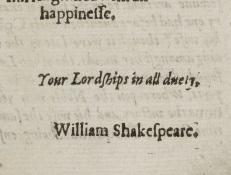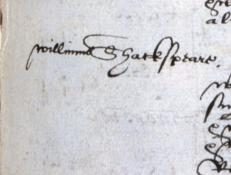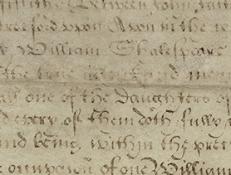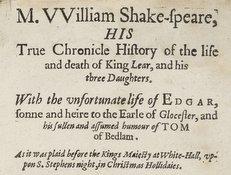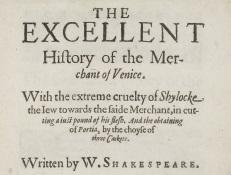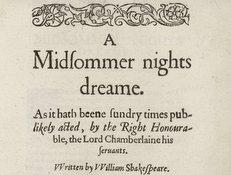To view a sortable list, please visit the Resource
All Documents
1616
The sixth edition of Lucrece was printed by Thomas Snodham for Roger Jackson in 1616, the year of Shakespeare’s death.
June 22, 1616
The original copy of Shakespeare’s last will and testament was probated on June 22, 1616, and an entry in the parchment register, shown here, was made recording the date of probate.
1616
The Shakespeare First Folio (1623) contains a list of “The Names of the Principall Actors in all these Playes.” At the head of the list appears the name of William Shakespeare.
1617
William Stansby printed the eleventh edition of Venus and Adonis for William Barrett in 1617. William Leake had transferred the right to publish Venus and Adonis to Barrett earlier that year on February 16, 1617.
February 10, 1618
On February 10, 1618, five years after William Shakespeare and his associates William Johnson, John Jackson, and John Heminges agreed to purchase the Blackfriars Gatehouse in 1613, Shakespeare’s trustees transferred the title of the Gatehouse to two new trustees.
1619
In 1619, William Jaggard and Thomas Pavier issued a joint reprinting of the anonymous plays The First Part of the Contention (1594) and The True Tragedy of Richard Duke of York (1595), titled The Whole Contention Between the Tw
Printed as 1608, i.e. 1619
SHAKESPEARE DOCUMENTED IS STILL GROWING! Descriptive content and transcriptions will continue to be added, updated and expanded. Check back for regular updates!
Printed as 1600, i.e. 1619
SHAKESPEARE DOCUMENTED IS STILL GROWING! Descriptive content and transcriptions will continue to be added, updated and expanded. Check back for regular updates!
Printed as 1600, i.e. 1619
SHAKESPEARE DOCUMENTED IS STILL GROWING! Descriptive content and transcriptions will continue to be added, updated and expanded. Check back for regular updates!
1619
The fourth edition of Pericles was published by Thomas Pavier and printed by William Jaggard in 1619. Pavier and Jaggard printed ten plays by or attributed to Shakespeare, now known to scholars as the Pavier quartos.

